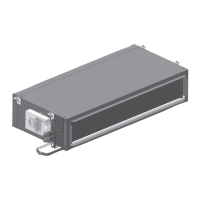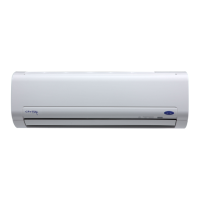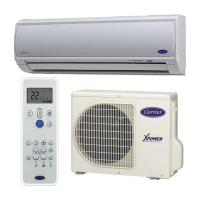Water inlets/outlets, all sizes : Fig. 14.
WARNING: Carefully observe the direction indicated by
the arrow on the valves, based on the valve type.
These are manufactured from high density plastic with a
VO re rating, more or less equivalent to class M1 (French
standard). They are encased inside the unit. The ducts should
be xed to these spigots using circular collars or adhesive.
Screws and rivets should not be used.
WARNING: In order to guarantee good air tightness, the
duct should overlap the whole of the spigot.
Make sure that the maximum supply air temperature does
not exceed 60°C.
Do not lift or support the unit using the spigots, place loads
on the spigots during installation or operation.
When connecting rectangular anges to the inlet and the
outlet make sure that the duct is pushed closely the unit.
The Carrier unit is tted with G1 lter as standard. As an
option, a G3 or a M5 Filter can also be provided according
to EN 779 standard. The G3 and M5 lter are compliant to
M1 re rating (according to NFP 92-507 standard).
Different lter access are available:
• Unit without rectangular ange air inlet (plain inlet):
access is from the rear of the unit.
• Unit with rectangular ange air inlet or with return
air plenum: access is from below (trapdoor).
Air lters should be changed regularly. Filter life depends
on the rate at which the lter becomes clogged, which
depends upon the cleanliness of the working environment.
If clogged lters are not changed they can increase the air
pressure drop, trapped dust particles may be given off and
entrained in the air supply, and the general performance of
the unit may be degraded (as the air ow reduces).
NOTE: When installing a unit in a ceiling void, check that
no T-bars will obstruct lter access and removal.
4.7 - Fresh air controller
The unit can be tted with three ranges of constant and
adjustable fresh air ow. The 3 ranges are 15 to 50 m
3
/h, 50
to 100 m
3
/h and 100 to 180 m
3
/h.
The diameter of the spigot housing the fresh air flow
controller is 125 mm. The fresh air controller can be modied
on site by unscrewing and repositioning the damper of the
controller. See g 17.
IMPORTANT: If the unit is fitted with a return air
temperature sensor, the constant fresh air ow rate must
not exceed 50% of the supply air ow delivered by the unit
at minimum speed.
NOTE: To operate correctly the constant fresh air ow
controller requires a differential pressure in the range of
60 Pa to 210 Pa.
The unit can be equipped with a variable fresh air ow
controller from 0 to 55 l/s (0 to 200 m
3
/h).
This is connected to the numeric Carrier controller and can
regulate the fresh air intake in two ways:
• Either using a xed rate set by the installer that can
be recongured as required
• Or based on the CO
2
level; in this case it is connected
to a CO
2
sensor via the Carrier numeric controller
(the CO
2
sensor is located opposite the fresh air inlet).
NOTE: With the variable fresh air ow controller the
upstream pressure in the fresh air duct must be 180 Pa. It
is available as an accessory.
If the unit is provided without any lter or if the fresh air
inlet is tted in the base unit or in the return plenum, it is
the responsibility of the installer to check if the fresh air is
ltered beforehand.
These valves are either two-way or four-way type (three-way
with integral bypass). The body of the valve is designed to
withstand a 15.5 bar (1550 kPa) bar operating pressure.
With this option, the couple (valve + actuator) is usually
normally closed (NC).Thus, the water ow is null in case of
power cut. To ll the installation, to equalise the water
circuits and to purge the units, the actuators must be
connected to the power supply and the valves must be
opened via the controller (thermostats or BMS).
For the replacement of these components refer to the
chapter 4.8.4. - ‘‘Actuator replacement procedure’’.

